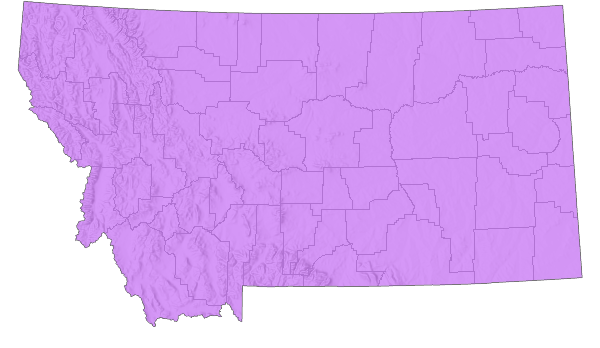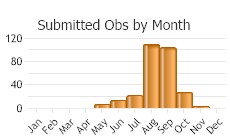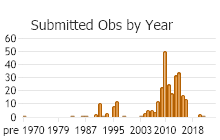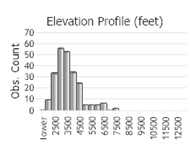View in other NatureServe Network Field Guides
NatureServe
Montana
Utah
Wyoming
Idaho
Wisconsin
British Columbia
South Carolina
Yukon
California
New York
Spotted Spreadwing - Lestes congener
Native Species
Global Rank:
G5
State Rank:
S5
Agency Status
USFWS:
USFS:
BLM:
External Links
General Description
The Spotted Spreadwing is a rather dull brown spreadwing damselfly. Dark spots on the sides of the thorax distinctive. Spots appear to be the only spreadwings with males having lower surface of eyes brown. Pruniosity on the tip of the abdomen not quite as conspicuous as only co-occuring spreadwings--the Northern, Emerald or Lyre-tipped.
Diagnostic Characteristics
The Spotted Spreadwing is a rather dull brown spreadwing damselfly. Dark spots on the sides of the thorax distinctive. Spotteds apprear to be the only spreadwings with males having lower surface of eyes brown. Pruniosity on the tip of the abdomen not quite as conspicuous as only co-occuring spreadwings--the Northern, Emerald or Lyre-tipped.
Species Range
Montana Range
Range Descriptions

 Native
Native
Range Comments
Common species statewide in Montana ponds and lakes.
Observations in Montana Natural Heritage Program Database
Number of Observations: 295
(Click on the following maps and charts to see full sized version)
Map Help and Descriptions
Relative Density

Recency



 (Observations spanning multiple months or years are excluded from time charts)
(Observations spanning multiple months or years are excluded from time charts)
Habitat
The habitat of the Spotted Spreadwing includes marsh-emergent vegetation bordered lakes and ponds, small ponds, pools, swamps and sluggish backwaters and slow streams as well as saline lakes. It is common for the breeding ponds to dry up sometime during the summer months (Westfall and May 1996, Nikula et al. 2002, Acorn 2004, Paulson 2009).
National Vegetation Classification System Groups Associated with this Species
Wetland and Riparian
Alkaline - Saline Wetlands
Alpine Riparian and Wetland
Peatland
Riparian and Wetland Forest
Wet Meadow and Marsh
Food Habits
Larvae feed on a wide variety of aquatic insects, such as mosquito larvae, other aquatic fly larvae, mayfly larvae, and freshwater shrimp.
Adult- This damselfly will eat almost any soft-bodied flying insect including mosquitoes, flies, small moths, mayflies, and flying ants or termites.
Reproductive Characteristics
Male Spotted Spreadwings are present in tall emergent vegetation. However, they often mate with females away from breeding sites and pairs arrive in tandem. Oviposition is done in tandem with female slicing into the stems of emergent vegetation (usually bulrushes) with ovipositor. The pairs moves down stem depositing eggs with males often releasing the female to complete oviposition alone (Nikula et al. 2002, Paulson 2009).
Intertingly, the egg of the Spotted Spreadwing halts its development at an early stage and is basically dormant throughout the winter months, easily surviving extremely cold temperatures and desiccation. When spring arrives, the eggs continue development and larvae hatch later in the summer than other spreadwings. As a result of this delay, adult Spotted Spreadwings are often the last Lestes species to be found in the fall (Acorn 2004).
Stewardship Responsibility
References
- Literature Cited AboveLegend:
 View Online Publication
View Online Publication Acorn, J. 2004. Damselflies of Alberta: flying neon toothpicks in grass. Edmonton, Alberta: University of Alberta Press. 156 pp.
Acorn, J. 2004. Damselflies of Alberta: flying neon toothpicks in grass. Edmonton, Alberta: University of Alberta Press. 156 pp. Nikula, B., J. Sones, D.W. Stokes, and L.Q. Stokes. 2002. Stokes beginner's guide to dragonflies and damselflies. Boston: Little, Brown. 159 pp.
Nikula, B., J. Sones, D.W. Stokes, and L.Q. Stokes. 2002. Stokes beginner's guide to dragonflies and damselflies. Boston: Little, Brown. 159 pp. Paulson, D.R. 2009. Dragonflies and Damselflies of the West. Princeton University Press, Princeton. 535 pp.
Paulson, D.R. 2009. Dragonflies and Damselflies of the West. Princeton University Press, Princeton. 535 pp. Westfall, M.J., Jr. and M.L. May. 1996. Damselflies of North America. Scientific Publishers, Gainesville, Florida. 649 pp.
Westfall, M.J., Jr. and M.L. May. 1996. Damselflies of North America. Scientific Publishers, Gainesville, Florida. 649 pp.
- Additional ReferencesLegend:
 View Online Publication
View Online Publication
Do you know of a citation we're missing? Dunkle, S.W. 2000. Dragonflies through binoculars: A field guide to dragonflies of North America. New York, NY. Oxford University Press. 266 pp.
Dunkle, S.W. 2000. Dragonflies through binoculars: A field guide to dragonflies of North America. New York, NY. Oxford University Press. 266 pp. Sater, S. 2022. The insects of Sevenmile Creek, a pictorial guide to their diversity and ecology. Undergraduate Thesis. Helena, MT: Carroll College. 242 p.
Sater, S. 2022. The insects of Sevenmile Creek, a pictorial guide to their diversity and ecology. Undergraduate Thesis. Helena, MT: Carroll College. 242 p.
- Web Search Engines for Articles on "Spotted Spreadwing"
- Additional Sources of Information Related to "Insects"





